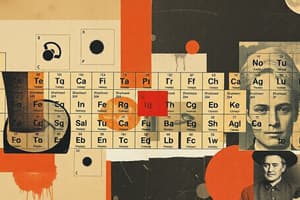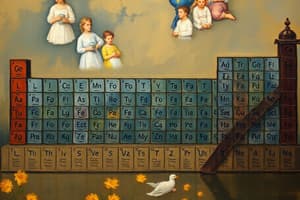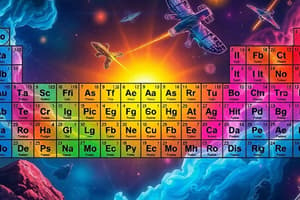Podcast
Questions and Answers
Which property is NOT true about alkali metals?
Which property is NOT true about alkali metals?
- They are very reactive.
- They are hard and dense. (correct)
- They are stored in oil.
- They float on water.
Francesium is the least reactive alkali metal.
Francesium is the least reactive alkali metal.
False (B)
What is formed when alkali metals react with water?
What is formed when alkali metals react with water?
metal hydroxide and hydrogen
Sodium reacts with water to form __________ and hydrogen.
Sodium reacts with water to form __________ and hydrogen.
Match the alkali metal with its reaction product when reacted with water:
Match the alkali metal with its reaction product when reacted with water:
Which noble gas has the highest boiling point?
Which noble gas has the highest boiling point?
The boiling points of noble gases decrease as you go down the group.
The boiling points of noble gases decrease as you go down the group.
What is the relative atomic mass of Argon?
What is the relative atomic mass of Argon?
The boiling point of Neon is _____ °C.
The boiling point of Neon is _____ °C.
Match the following noble gases with their respective relative atomic mass:
Match the following noble gases with their respective relative atomic mass:
Which halogen is the least reactive?
Which halogen is the least reactive?
Sodium reacts more vigorously with water than potassium.
Sodium reacts more vigorously with water than potassium.
Describe the appearance of bromine at room temperature.
Describe the appearance of bromine at room temperature.
Chlorine will displace bromine in the reaction between potassium bromide and _____.
Chlorine will displace bromine in the reaction between potassium bromide and _____.
Match the following elements with their state at room temperature.
Match the following elements with their state at room temperature.
What will happen when potassium bromide is reacted with iodine?
What will happen when potassium bromide is reacted with iodine?
Which of the following pairs of elements are likely to have similar properties?
Which of the following pairs of elements are likely to have similar properties?
The rows of the Periodic Table are called groups.
The rows of the Periodic Table are called groups.
Fluorine can displace chlorine in a reaction.
Fluorine can displace chlorine in a reaction.
What happens to magnesium's insulating properties when it is combined with a non-metal such as sulfur?
What happens to magnesium's insulating properties when it is combined with a non-metal such as sulfur?
What is produced when sodium chloride reacts with fluorine?
What is produced when sodium chloride reacts with fluorine?
Calcium + water → __________
Calcium + water → __________
Match the following groups with their properties:
Match the following groups with their properties:
Which of the following statements is true about elements in the same group of the Periodic Table?
Which of the following statements is true about elements in the same group of the Periodic Table?
Carbon dioxide is included in the Periodic Table.
Carbon dioxide is included in the Periodic Table.
Name one of the physical properties of Group 0 elements.
Name one of the physical properties of Group 0 elements.
Flashcards
Alkali Metals
Alkali Metals
The elements in Group 1 of the periodic table are known as alkali metals, which are highly reactive and rarely found in their pure form.
Reaction of Alkali Metals with Water
Reaction of Alkali Metals with Water
Alkali metals react with water to form a metal hydroxide and hydrogen gas.
Metal Hydroxide
Metal Hydroxide
A chemical compound with a hydroxide ion(OH-) and a metal cation.
Sodium
Sodium
Signup and view all the flashcards
Potassium
Potassium
Signup and view all the flashcards
Electronegativity
Electronegativity
Signup and view all the flashcards
Metallic character
Metallic character
Signup and view all the flashcards
Non-metallic character
Non-metallic character
Signup and view all the flashcards
Atomic radius
Atomic radius
Signup and view all the flashcards
Ionization energy
Ionization energy
Signup and view all the flashcards
Group
Group
Signup and view all the flashcards
Period
Period
Signup and view all the flashcards
Reactivity
Reactivity
Signup and view all the flashcards
Conductivity
Conductivity
Signup and view all the flashcards
Malleability
Malleability
Signup and view all the flashcards
Ductility
Ductility
Signup and view all the flashcards
Displacement reaction
Displacement reaction
Signup and view all the flashcards
Group 0 elements
Group 0 elements
Signup and view all the flashcards
Sodium + water →
Sodium + water →
Signup and view all the flashcards
Potassium + water →
Potassium + water →
Signup and view all the flashcards
Reactivity of Alkali Metals with Water
Reactivity of Alkali Metals with Water
Signup and view all the flashcards
Halogens
Halogens
Signup and view all the flashcards
Reactivity of Astatine
Reactivity of Astatine
Signup and view all the flashcards
Halogen Displacement Reactions
Halogen Displacement Reactions
Signup and view all the flashcards
Halogen Displacement Reactions (no Displacement)
Halogen Displacement Reactions (no Displacement)
Signup and view all the flashcards
Lithium Bromide + Iodine →
Lithium Bromide + Iodine →
Signup and view all the flashcards
Study Notes
Lesson Outcomes
- Classify elements as metals or non-metals using patterns
- Predict element properties using patterns
- Compare and describe element properties in groups and periods of the periodic table.
- Interpret data to describe group 1, 7 and 0 elements' properties.
- Describe displacement reactions
- Describe physical and chemical properties of group 0 elements
Starter Retrieval Questions
- Complete chemical equations for reactions involving Zinc, Copper, Calcium, Magnesium and Lithium with various reagents.
Paired Task
- List as many elements as possible from memory.
- Explain why Carbon Dioxide is not on the periodic table (it is a compound)
Independent Task
- Identify the section of the Periodic Table containing non-metals.
- Identify if section A contains metals or non-metals
- Categorise properties (conductor/insulator of heat/electricity, shiny, low/high density, brittle/malleable, ductile, sonorous) as belonging to metals, non-metals or both.
- Determine if an unknown element is a metal or non-metal based on its properties (sonorous, conducts electricity, ductile).
- Explain magnesium's change in properties when bonded with another non metal (e.g., sulfur)
Groups and Periods
- Elements in the same group have similar properties (reactivity and density)
- Periods are horizontal rows on the periodic table. Each period corresponds to a number of electron shells in an atom.
Learning Pitstop
- Periodic table rows are called periods, columns are called groups
- Identify pairs of elements that would have similar properties based on periodic table trends.
Group 1 Alkali Metals
- Alkali metals (Group 1) are very reactive and rarely found in their elemental form.
- Stored in oil to prevent air reactions.
- Soft, dense, and float on water.
- React with water to form alkaline compounds.
Halogens Group 7
- Halogens (Group 7) are non-metals, toxic, and exhibit varying reactivity.
- Fluorine is the most reactive, astatine is least.
- More reactive elements displace less reactive elements in reactions.
- Halogens exist in different states at room temperature (e.g., gases, liquids)
Noble Gases Group 0/8
- Noble gases (Group 0/8) are colourless, odourless, and unreactive.
- Boiling points increase as you move down the group.
Plenary
- Categorise properties of noble gases in Groups 0/8 as physical or chemical.
- Differentiate between chemical and physical properties with examples.
- Predict if xenon will react with nitrogen (predict no reaction).
- Predict the boiling point of Krypton.
Studying That Suits You
Use AI to generate personalized quizzes and flashcards to suit your learning preferences.
Related Documents
Description
This quiz covers the classification of elements as metals and non-metals by identifying patterns in their properties. Participants will predict element characteristics and describe displacement reactions, particularly in groups 1, 7, and 0 of the periodic table. It's a comprehensive assessment of understanding the periodic table.




